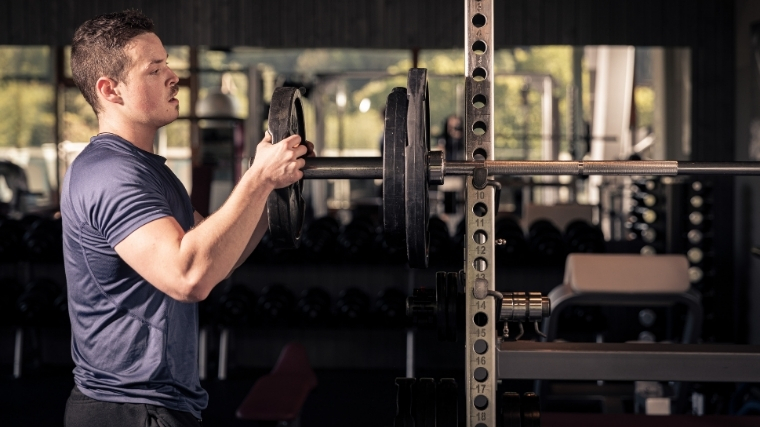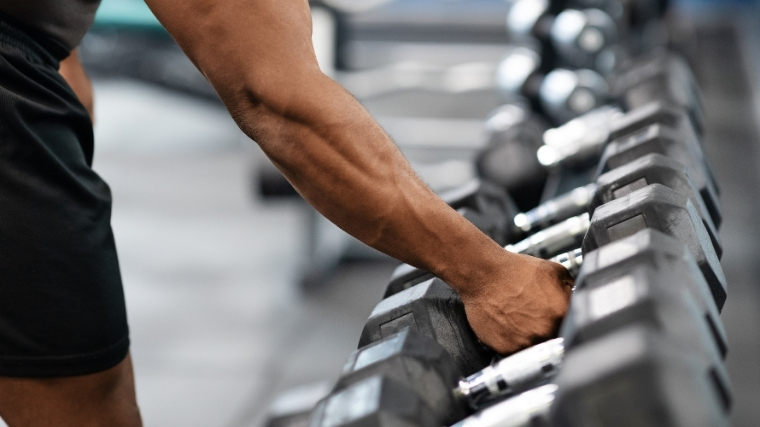If you have any experience with deadlifting, then you know how much it sucks when the knurling clips your shins, especially if you forget to wear your deadlift socks. Knicked shins don’t just hurt, but they can potentially lead to illness, too. That’s because your gym is dirty. Ok, ok, you’re probably not shocked to hear that, but take a second to think about how many hands probably grip your gym’s barbells, kettlebells, or dumbbells on any given day. A lot. Sweaty, grimy, possibly unwashed hands.
After doing some digging, we’ve found research that shines a light on gym surfaces and the germ microbiomes that inhabit them. Below, we’ll go over what the research says about germs in the gym and give you some advice on avoiding getting sick (spoiler alert: it’s nothing you don’t already know).
Germ Research
Basic Germ Terminology
To kick off the germ-ridden research below, it’s important to understand some common terms used to define what the research found.
- Microbiome: The full list of microorganisms living in a particular environment.
- Pathogens: Bacteria, germs, and other microorganisms that can cause disease.
- Microbial: A characteristic or relating feature of a microorganism that causes disease.
- Phyla: Divisions used to classify bacteria.
- Microorganism: Consist of things like bacteria, fungus, and viruses.
- Fomite: A material/surface that can carry infections.
There are many more terms used in the definitions above and what’s often used in research assessing germ microbiomes. It’s also worth noting that germs often include four categories: bacteria, viruses, fungi, and protozoa.

[Related: What You Need to Know About How to Build Muscle]
Germs in the Gym
First, take a look at a study that comes from 2014. In this study, researchers analyzed the setting of various recreational gyms in Memphis, Tennessee. For their research, the study authors analyzed the surfaces of multiple pieces of equipment, including Nautilus® machines, treadmills, stationary bike, power strider, elliptical machine, leg press, dumbbell, toilet handles, and handrails on stairs.
To obtain the samples, researchers swabbed each of these areas before they had been sanitized. Researchers extracted the genomic DNA from the swabs and then divided samples into their respective gym surface groups (i.e., dumbbells together). After that, researchers split their samples into respective phylum classes.
Phylum Classes
Below are the three divisions of phylum researchers grouped the bacteria into. Within each of these groups, there are multiple types of bacterial families, and not all of them are harmful to humans. For example, the bacteria strand Staphylococcaceae (commonly known as Staph) comes in multiple forms. Not all of them are equal in terms of their impacts on human health (MRSA is what most think when they hear Staph infection).
- Firmicutes: Division of phylum with the gram-positive wall structure.
- Proteobacteria: Division of phylum with gram-negative bacteria.
- Actinobacteria: Division of phylum with gram-positive bacteria.
Not All Surfaces Carry the Same Germs
From their research, authors found that not all surfaces are created equal when it comes to the diversification of the three phyla above. For example, the treadmill, power strider, elliptical, nautilus, and leg press were heavily covered with Firmicutes, while the toilet handles and rails were primarily covered in Proteobacteria; the dumbbell and stationary bike were covered heavily by Actinobacteria.
Going a step further, researchers identified which germ families occupied each piece of equipment the most. Before reading further, it’s important to keep in mind that while there are harmful strands within each bacteria genus listed below, not all are harmful to health. The chart below shows the piece of equipment used in the study with the most prevalent bacteria genus (multiple families occupy each, but these are the heaviest).
| Elliptical: Staphylococcaceae | Stationary Bike: Microbacteriaceae |
| Power Strider: Staphylococcaceae | Leg Press: Aerococcaceae |
| Nautilus®: Staphylococcaceae | Treadmill: Bacillaceae |
| Dumbbell: Microbacteriaceae | Toilet Handle: Enterobacteriaceae |
Authors pointed out the diverse bacterial families that occupied each piece of equipment because strands of Staphylococcaceae were the most consistently prevalent. Researchers also noted that bacteria were spread in the gym setting through multiple means, including air, dust, soil, water, and human flora.
Hygiene is Important to Prevent the Spread of Germs
To conclude their research, the authors stated that pathogenic bacteria found on the surfaces were relatively low (if at all). The authors also mentioned that the gym’s environment (humidity, ventilation system, and so forth) all play roles in the life of bacteria on surfaces. Additionally, the researchers acknowledged that many of these bacterial families (pathogenic included) could be spread through touch. Still, chances are relatively low for this, and research is limited in the prevalence of doing so. (1)
Yet, there are harmful bacterial families present on gym surfaces, which illustrates the importance of personal hygiene. To wrap up their research, the authors said, “It is critical to underscore the need of proper hygienic practices in fitness centers and gyms for minimizing the spread of disease-causing organisms.”
Bacteria Vs. Viruses on Gym Surfaces
Another interesting study worth covering is this research from 2006. In this study, examiners looked at the differences in bacteria and virus composition on gym surface areas (fomites) pre and post-exercise. Also, they assessed how much equipment disinfection helped. For their research, they analyzed both aerobic and weight training gear in both settings.
They found that benign bacteria were present on equipment pre and post-exercise, but pathogenic bacteria was scarce and not prevalent. In respect to virus strains, they found that 63 of the 100 hand-surface areas contained viruses (most commonly rhinovirus, aka the ‘common cold’). The authors also noted that weight training equipment contained more viruses than aerobic pieces of equipment.

[Related: How to Burn Fat for Weight Loss and More Definition]
In conclusion, the authors expressed that disinfection of equipment could be useful but isn’t a be-all-end-all with resisting viruses, as surfaces were 48% positive pre-cleaning vs. 86% positive post-cleaning. Their closing remarks entailed that the gym fomites analyzed in their research didn’t contain pathogenic bacteria but did carry viruses. (2)
Germ & Gym Research Takeaways
This article wasn’t intended to scare you or create a germaphobe view of your normal gym, but to merely bring up how dirty some of the surface areas can be, along with how important personal/facility hygiene is. Below are three takeaways from the research reviewed.
- Pathogenic bacteria on equipment is scarce, but there’s always a small chance of potentially harmful bacteria getting passed along from skin-to-skin fomites.
- Viruses are more common on gym equipment when compared to pathogenic bacteria, and it’s best to place a heavy emphasis on personal hygiene when working out.
- Personal hygiene is your best defense to resisting potentially harmful microorganisms at gyms that are loaded with bacteria.
Simple things like wiping down equipment, avoiding contact like touching your face as you work out, and washing your hands after lifting can go a long way to preventing the spread of germs in and outside the gym. There’s limited research on the topics of what’s consistently the most germ-ridden in terms of specific equipment containing germs.
References
- Mukherjee N, Dowd SE, Wise A, Kedia S, Vohra V, Banerjee P. Diversity of bacterial communities of fitness center surfaces in a U.S. metropolitan area. Int J Environ Res Public Health. 2014;11(12):12544-12561. Published 2014 Dec 3. doi:10.3390/ijerph111212544
- Goldhammer KA, Dooley DP, Ayala E, Zera W, Hill BL. Prospective study of bacterial and viral contamination of exercise equipment. Clin J Sport Med. 2006 Jan;16(1):34-8. doi: 10.1097/01.jsm.0000181436.41268.1f. PMID: 16377973.
Featured image: Joachim Klingner/Shutterstock